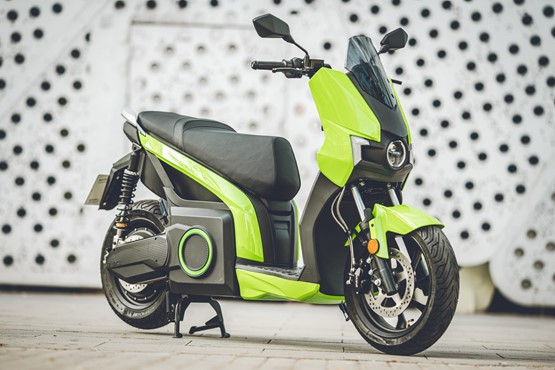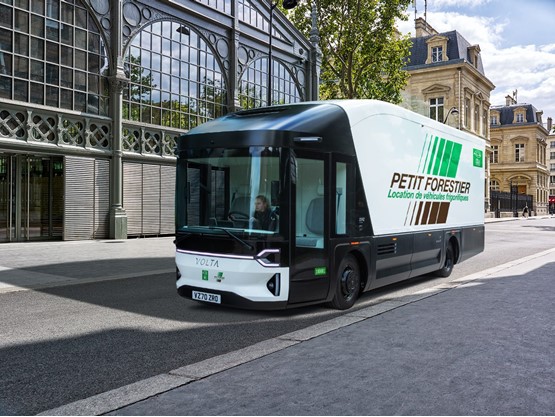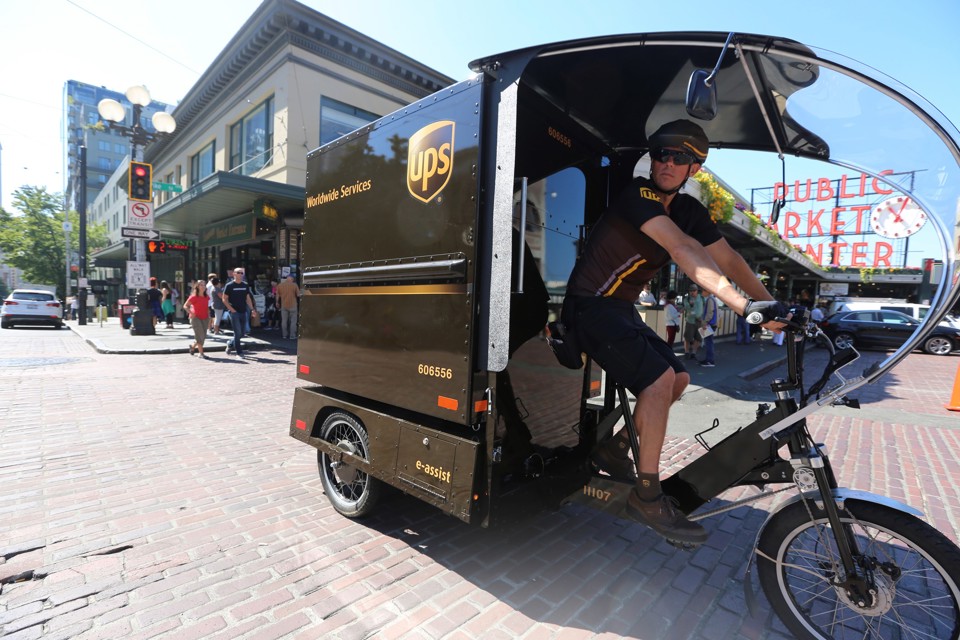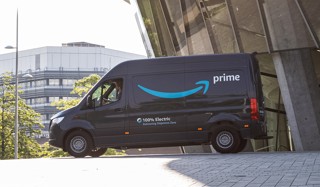Tighter controls on vehicle emissions imposed by city authorities plus pressure from environmentally-conscious customers mean that van and truck fleets are having to rethink their approach to operating in urban areas.
In some cases this means abandoning conventional vehicles altogether – a choice being made by a growing number of businesses.
This could involve using battery electric vehicles (BEVs) or adopting new delivery methods altogether, such as e-cargo bikes, scooters or autonomous wheeled robots.
The changing urban environment will also mean large commercial vehicles will no longer drive long distances to make deliveries.
Instead, they will head to out-of-town hubs where goods will be taken before being delivered by smaller, low-emission vehicles for the final, short leg of the journey.
One of the biggest challenges for last-mile delivery fleets in urban areas will be locating places where goods can be stored temporarily prior to being taken to the customer’s door.
“Finding local warehouse space for sorting and consolidating consignments is difficult, and can be even harder than sourcing larger fulfilment facilities,” says Louisa Hosegood, digital and strategy director at supply chain and logistics consultants Bis Henderson Consulting.
Big or small, there is no guarantee your chosen site will receive planning consent.
Customers may want the items they order online to be delivered quickly, “yet these same consumers, as residents, oppose plans for industrial development in conurbations, as seen by the recent rejection of Ocado’s fulfilment centre expansion in the London Borough of Islington”, she adds.
Residents’ opposition to the expansion under the ‘Nocado’ banner was highly-organised and professionally-executed.
Consent, however, is more likely to be granted if the development can boast some environmental credentials.
Distribution partnership
Two big warehouses – one in the East Midlands, another in East London – are to be built as part of a Mars/DHL distribution partnership.
Representing an investment of £350 million, they have been designed with sustainability in mind, says Mars.
They will be partially solar-powered and will rate in the top 1% of non-domestic buildings in the UK environmentally, the company adds. Both are scheduled to be operational by spring 2023.
Mars says the warehouses will play a key role in a reorganised logistics operation that will remove one million miles a year from Britain’s roads – the equivalent of 40 times around the world, or 8,547 times around the M25.
The changes that will be rolled out will cut Mars’ annual outbound logistics carbon footprint in the UK by 7.7%, equivalent to the annual emissions generated by heating 543 average homes.
One company which has recently overcome the potential planning obstacle is online retail giant Amazon, which last month set up a last-mile logistics hub in the heart of London.
The City of London Corporation granted planning permission to convert an underused public car park near London Wall to become a distribution hub for Amazon Logistics.
This will be the base for couriers to make deliveries within a 1.2-mile radius on either e-cargo bikes or on foot.
City of London Corporation plans to create two more last-mile logistics hubs by 2022 and to have a total of five by 2025.
“The Amazon Last Mile Logistics Hub alone will take up to 95 vehicles off the road each day, meaning up to 23,000 fewer vehicle journeys in central London every year,” says Alistair Moss, chair of the corporation’s planning committee.
Many other organisations are also already using e-cargo bikes for last-mile deliveries, such as CitySprint and Co-op, but their use is not confined to London.
Zmove, for example, has been using them to provide a delivery service for Newcastle upon Tyne Hospitals NHS Foundation Trust.
They can use routes, including river crossings, that may be unavailable to mainstream vehicles, and get close to customers’ doors. Goods can often be delivered more rapidly as a result.
Sainsbury’s Chop Chop service enables consumers to order up to 20 products from a range of around 3,000 grocery and household items using an app.
The items are delivered by cycle couriers within the hour from 50 of the supermarket chain’s stores spread across 20 UK cities.
UPS has started deploying e-cargo bike globally as part of 30 urban logistics projects, including Dublin, where it has has set up a delivery hub at Trinity College.
However, it took a different approach in the UK with a trial of electric power-assisted trailers pulled by bicycles. Part-funded by Innovate UK and run in conjunction with the University of Huddersfield, the Low Impact City Logistics Project gave UPS a better understanding of e-assist products, including a version of the trailer which can be guided by a pedestrian.
The trial ended two years ago and is not expected to be repeated.
A spokesman says: “There is no one-size-fits-all solution when it comes to sustainable last-mile deliveries in busy city centres. Every city has different challenges and requirements and London, as a major metropolis, is particularly complex. But we will continue looking for opportunities to establish our City Logistics project there in the future.”
 Meanwhile, Silence UK says electric scooters could have a growing role to play in urban delivery networks.
Meanwhile, Silence UK says electric scooters could have a growing role to play in urban delivery networks.
The company is targeting the Spanish-made SO2 and SO2 LS Long Range models at business users.
Both can be equipped with large top boxes which can be used to accommodate packages and offer a claimed range of 80 miles and 91 miles respectively.
Running costs add up to a meagre £1 per 100 miles travelled, claims Silence.
Top box capacity can be as much as 350 litres and the scooter can typically handle a payload of around 100kg, says Silence UK founding partner, Tony Lewis, a motor industry veteran who has worked for LDV and Nissan.
“Much depends on the weight of the rider though,” he says.
Electric scooters require riders, but some businesses are taking human beings out of the delivery equation.
The Co-op is using battery-powered autonomous wheeled robots developed by Starship Technologies to deliver goods to householders in Northampton and Milton Keynes.
Sensors, machine-learning and artificial intelligence help them avoid obstacles and reach their destinations.
Amazon has deployed electric, autonomous package delivery robots in the USA while the autonomous Kar-go Delivery Bott from UK start-up Academy of Robotics is now on trial with a chemist in the London Borough of Hounslow, delivering medicines to local customers.
The customers have an app on their smartphone which tells them when their package has arrived.
They then go outside and use the app to unlock the vehicle to get the item they are expecting.
It is, of course, debatable how far autonomous vehicles will prove popular or practical in home delivery work.
A delivery driver can carry groceries up to a third floor flat, or into an elderly lady’s kitchen. A delivery robot cannot.
While undoubtedly environmentally-friendly, transport like e-cargo bike or scooters does not have the capacity to cope with palletised loads – half-a-dozen pallets of cat food, for instance – or with bulky, heavy items sometimes referred to as ugly freight. Bigger zero-emission vehicles are required to handle such tasks and more are becoming available.
Rising interest has created an opening for a variety of start-ups that are competing for business with more familiar names.
Among the former is Volta Trucks. It has developed the electric Volta Zero 16-tonner scheduled to be on trial with DPD in London’s ultra-low emission zone, with a claimed range of up to 125 miles.
Benefits of battery power
Battery power looks set to be the favoured emission-free option in urban areas given that most journeys are comparatively short; shorter than, say, driving from London to Manchester.
Volta addresses another issue which businesses operating in urban areas will increasingly need to weave into the equation: the need to interact safely with vulnerable road users such as cyclists, scooter riders and pedestrians crossing the street.
In the capital, this requirement is enshrined in the Transport for London (TfL) Direct Vision Standard, due to be enforced from March 1.
As a consequence, Volta Zero has a low-slung glasshouse-style cab not dissimilar to the one fitted to Mercedes-Benz’s Econic.
With an eye-line set at around 1.8m, drivers can communicate with pedestrians and other vulnerable highway users visually through 220 degrees.
A 360-degree birds-eye view camera shows drivers their complete surroundings, a blind-spot warning system has been fitted and the exterior rear view mirrors have been replaced by cameras.
 Refrigerated truck rental company Petit Forestier has inked a deal to acquire 1,000 Volta Zeros.
Refrigerated truck rental company Petit Forestier has inked a deal to acquire 1,000 Volta Zeros.
DHL, too, has been trialling a battery-powered 16-tonner in London, the Volvo FL Electric.
Putting the infrastructure in place to recharge electric van and truck batteries in an urban area as diesels become marginalised will become increasingly necessary, but can be expensive.
City of London Corporation runs a fleet of electric vehicles (EVs). They include road sweepers and seven Dennis Eagle Elite 26-tonne bin wagons converted to run on batteries by Electra and operated in conjunction with Veolia.
As a consequence, a £250,000 electricity substation has had to be installed to help deliver the power needed to the corporation’s transport depot in Walbrook Wharf, Upper Thames Street.
UPS has chosen to support its London operation with a smart grid developed in conjunction with the capital’s Cross River Partnership and UK Power Networks Services.
It times and spreads the recharging of vehicles throughout the night; in effect, trebling charging capacity.
UPS has ordered 10,000 Generation 2 electric vans from British-based manufacturer Arrival, all of which should be delivering parcels in the UK, Europe and North America by 2024.
DPD plans to install 3,600 charge points and deploy 7,000 alternative fuel vehicles across 225 urban areas in 20 European countries.
As part of this, it aims to have zero- and low-emission models in service in 25 of Britain’s biggest towns and cities by 2025.
More than 10% of its UK fleet is already electric. The 700-plus battery-driven vans and trucks include Nissan e-NV200s, MAN eTGEs and Fuso eCanter 7.5-tonners.
The transition to BEVs is inevitable given the Government’s decision to ban sales of petrol and diesel cars and light commercial vehicles from 2030, while the demand for home deliveries is being driven by the meteoric rise in online shopping; a trend given rocket boosters by Covid-19.
Growth in internet sales
Latest figures from the Office for National Statistics show internet sales accounted for 36% of all UK retail sales in November 2020. In November 2006, this was a mere 2.8%. It seems likely to continue in that direction.
“E-commerce has grown massively, and probably permanently, during the pandemic to 30% or more of retail trade,” says Hosegood.
“Customers increasingly value the convenience, assurance, immediacy, pricing and safety of ordering online.”
While there is no suggestion city centre office blocks will disappear entirely, these deliveries could increasingly be to people working from suburban homes rather than city centre offices, with many businesses planning to continue with their home working policies post-Covid.
That will require a further shift in already-fast-changing distribution strategies; away from high streets and towards suburban housing estates.




















Login to comment
Comments
No comments have been made yet.